- Go to the Commons site
- Login
- Hover over Top right corner
- Hover down to My Groups
- Click on your Group (ex. Art 1010 Fall 2018 11:00 am)
- New page will open and on the top of the screen site toolbar will contain a PLUS sign
- Hover over the PLUS sign and click on Post
- Categories Post
- Press the BLUE BUTTON on the Right hand side labeled PUBLISH to finalize your post
Category: 11 AM Class
Humanism
Well, humanism is basically presenting human characteristics upon artwork or sculptures. The modern day answer or definition for humanism is supposedly the belief of humans should be showing respect towards other humans because they’re human or basically respect towards humanity. There are many sculptures that create a aspect of humanism that captures the structure of humans and their anatomy. The Greeks and Romans created sculptures that captured humanism while also capture the well-defined features of a human with detail. Their sculptures emphasized more depth towards anatomy and sports of hunting and such. Ancient Egyptians showed some artwork expressing human characteristics on deities. Some of the deities had heads of animals while some would just have human characters overall.
Unit 2 Summary: Ancient World
In this unit of the Ancient World we viewed and discussed art from different ancient civilizations. These civilizations were ancient Egypt, Mesopotamia, Greek, and Roman art. Although these civilization’s had different cultures their art had some similarities, and of course differences as well.
In Mesopotamian art one can often see a depiction of hierarchy. For example in class we went over the Standard of Ur 600-2400 B.C.E. which is like wooden box whose purpose is unclear. The Standard of Ur however is divided into registers which are horizontal divisions. At the lower registers one can see people of the working class possibly servants carrying items and herding animals. Through this piece of art we can infer agriculture was a part of the culture as well as trading which can be inferred through the different rocks found in it. At the top register we see the king which is way larger in scale compared to the rest of the people thus showing hierarchy and the significance of the king and emphasizing power.
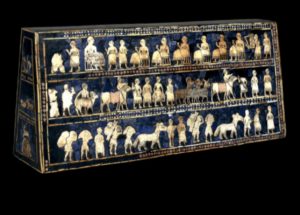
In Egyptian art they placed a great value on divine/supernatural beings. Most being Gods. These Gods were often depicted as half human half animal. For example Horus the sky god son of Isis and Osiris, who has a falcons head and human body. Egyptians also dealt a lot with the afterlife mummifying their dead and leaving treasures in there pyramids (specifically Kings and Queens). There are also various symbols and hieroglyphics. A similarity between Egyptian art and Mesopotamian is the resemblance of hierarchy but also the use of half human half animal statues, for example the Egyptians Sphinx and the Mesopotamian Lamassu which has the head of a man body of a bull or lion and wings of an eagle.
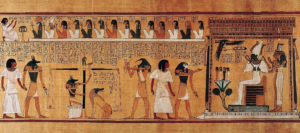
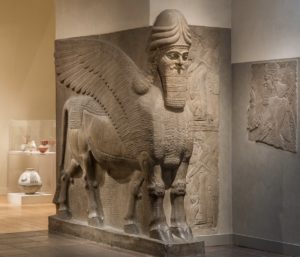
Lastly we went over Greek and Roman art. As stated in a previous post “Humanism is a philosophical system that highlights the importance and value of human beings rather than divine/supernatural matters. It has various characteristics. First it sought rational thinking, to look for explanations in the natural world. Thus encouraging the use of critical thinking leaving space for new speculations. It also placed human beings in the center of moral and social concerns. In terms of art it focused on the beauty of humans mainly man. It did this through the use of nudity in art.” (Blog post 7: Humanism) Both Greek and Romans focused on Humanism however most Roman sculptures had some sort of item of clothing. Greeks also mainly had nude statues of young males with athletic bodies and rarely used females nudes unless it was Aphrodite. Another difference between the Greek and Roman was the fact that Romans depicted aging and facial hair as opposed to Greeks. Contrapposto “an asymmetrical arrangement of the human figure in which the line of the arms and shoulders contrasts with while balancing those of the hips and legs.” (google definition) was a similarity they shared that differed from the Egyptians whose sculptures were often straight in posture and lean in muscle while Greek-Roman art highlighted the male body.
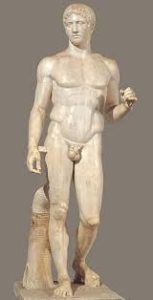
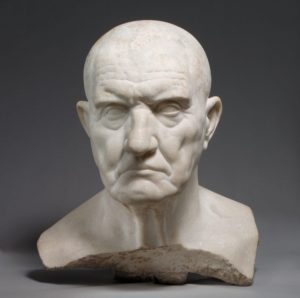
Overall this Unit was very informative on the Ancient Worlds art. It helped me make connections between the different civilizations and learn about new art terms and ideas like humanism and contrapposto.
Unit 2 summary
The concepts of statues was the first thing I think we learned. The value of the caving of concepts before the “gods”. The statues where small and had values either extrinsic to their life style or the sense of fear the the gods might smite them out of not being worshiped. while others become more tuned to their
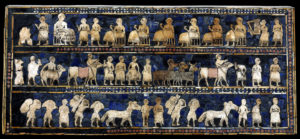 As time moved on the statues became larger and had more defined religious and cultural definition. The Egyptians and the Mesopotamian art was had a stronger focus on the spiritual deity in their cultures. The Mesopotamian statues where huge with beast like structures and a human head which was believed to be a deity that protected the structure within. While The Egyptians had the belief of the gods as a form of judgment on them and their culture surrounded the idea of dead and embalming creating statue that fit the surrounding terrain more than any thing else really. The Idea of a pharaoh and a orderly form of servants and people with relation to the gods was the main focus of creating monoliths specific to their culture. Building the pyramid as tomb and the temple around it showed the dedication to their belief. As shown the god of death Anubis is a man with a jackal head judging the peoples heart before he allows them to past.
As time moved on the statues became larger and had more defined religious and cultural definition. The Egyptians and the Mesopotamian art was had a stronger focus on the spiritual deity in their cultures. The Mesopotamian statues where huge with beast like structures and a human head which was believed to be a deity that protected the structure within. While The Egyptians had the belief of the gods as a form of judgment on them and their culture surrounded the idea of dead and embalming creating statue that fit the surrounding terrain more than any thing else really. The Idea of a pharaoh and a orderly form of servants and people with relation to the gods was the main focus of creating monoliths specific to their culture. Building the pyramid as tomb and the temple around it showed the dedication to their belief. As shown the god of death Anubis is a man with a jackal head judging the peoples heart before he allows them to past.
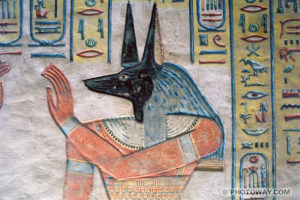
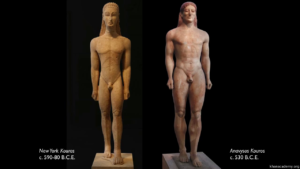 The Greeks and the Romans define their art to be more human creating marble statues that celebrates the human body “kouros” . The added humanism and color to the figure
The Greeks and the Romans define their art to be more human creating marble statues that celebrates the human body “kouros” . The added humanism and color to the figure
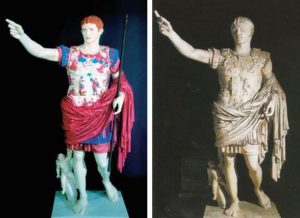 The Greeks that slowly moved from the ideal more symmetric structure of a ideal athletic figure to more of a organic human structure that has more of a curve and more realistic facial features. While still being faithful to their religion they portray their gods in marble to re enforce the concepts of their culture as people and how they also take advantages to the usage of the materiel to carve more intricate ideas into the statue it self
The Greeks that slowly moved from the ideal more symmetric structure of a ideal athletic figure to more of a organic human structure that has more of a curve and more realistic facial features. While still being faithful to their religion they portray their gods in marble to re enforce the concepts of their culture as people and how they also take advantages to the usage of the materiel to carve more intricate ideas into the statue it self
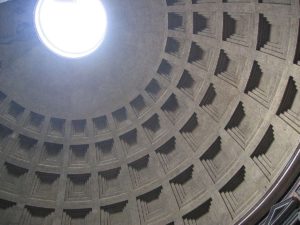
Temples where built using the concepts of math and advancements they had found and is also apart of what made the art pop out while being efficient at lowering the weight of the walls.
As they may still build as time moves on the statues are upgraded to being hollow cast in bronze and as time moved further on the fallout of the once beautiful art be came muddied over time and less persevered of the original intentions.
the thing that ties most of the art together would be the usage of color to show what their civilization has mastered and how it complements the art it self
Unit 2: The Ancient World
In unit 2, we explored art within Ancient civilizations, including Mesopotamia, Egypt, Greece, and Rome. Much like everything else, the history of their art also provided us with insight into the state of their society and environment, as well as their beliefs and values. These civilizations had many similarities and differences in their art, which also reflects what they considered to be of importance.
One of the most common theme amongst the art of the ancient world was religion. The Mesopotamian’s and the Egyptians were similar in the fact that their “Gods” often had animalistic features. This was a way to create obvious distinction between the power and status of the Gods and humans. We can also see the blatant socioeconomic differences between rulers and common civilians in both of these civilizations art. The Standard of Ur, from the Royal Tombs at Ur, is a good example of Mesopotamian art that depicts this. With two sides to the “standard” we can see the two sides of life at the time: peace and war. Not only does the standard depict order and chaos but it also makes the concepts of the class and hierarchal system of the society more evident. The people (and animals) on the bottom level, who are the common people are less detailed, while the people on the top who are royalty are much more detailed. This is similar to the Egyptian Palette of King Narmer, because it also portrays scenes of war, power, and hierarchy. Narmer, who was royalty and the Falcon, who was a God are both the biggest and most detailed are in the top level, to show their importance. Meanwhile, those on the bottom are much less important as they appear dead. This kind of art was common and showed that the people during this time valued royalty and religion. It also allows the audience a peek into the significant details and lifestyles of the civilizetions.
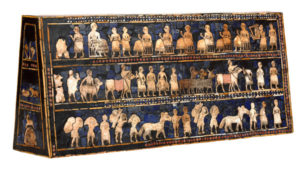
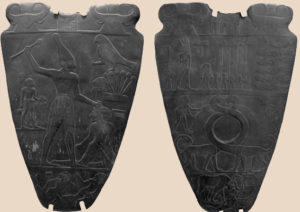
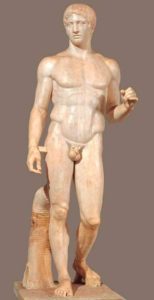
The Greek and Romans, unlike the Egyptians and Mesopotamians, embraced humanist concepts more frequently. They believed that embracing the human qualities was important and portrayed their Gods to have such qualities. While the Greeks used their ability to illustrate motion and stance in their more idealized versions of the human body, the Romans on the other hand chose to make their sculptures appear more lifelike by focusing on the details of the human body and face and not shying away from the “flaws” of humans. For example, Polykleitos’ Doryphoros represents the Greeks’ idealistic image of the male body. Doryphoros’ contrapposto stance, with his weight resting on one leg and his shoulders more balanced, provided a more realistic stance than those of sculptures from earlier civilizations. Nevertheless, where his body exuded strength, power, and athleticism, his face lacked any distinguishable features.

Despite taking inspiration from the Greeks, the Romans looked past the practically unattainable “perfect” male bodies, choosing to focus more on the imperfect human aspects. They even made sure their Gods were portrayed wearing clothes rather than complete nakedness. The Romans chose to go with the concept of portraiture because it reflected their goals as a Republic. They were eager to represent themselves with balding heads and wrinkles which they viewed as a way of showing wisdom and hard work rather than flaws.
Summary of Ancient Art-Unit 2
Art of the ancient world is an expression of the different cultures. The way the statues and art are made differ depending on what the culture deems important. For example, Mesopotamian and Egyptian art focus on Gds and Deities. While Greek culture is entirely different their art focused on Humanism. The idea that humans play an important role in society. This Humanistic belief is carried on to Roman culture with slight differences in the nuances.
 Mesopotamian and Egyptian art are both very expressionless and their figures are formed in a way that makes them seem aloof. They lack the curvature of a natural body and their figures lack movement. Formal frontality is used to describe the forward facing stance of most Egyptian sculptures. Most sculptures were used for ritual purposes often their hands are clasped and eyes wide which represents their attentive attributes towards the Gds. Ready to listen, pray, and perform for their Gds, all for the purpose of an afterlife. You can see in the image of King Menkaura his and Queen that although they have one forward in a sort of motion the rigid positions they are in lacking
Mesopotamian and Egyptian art are both very expressionless and their figures are formed in a way that makes them seem aloof. They lack the curvature of a natural body and their figures lack movement. Formal frontality is used to describe the forward facing stance of most Egyptian sculptures. Most sculptures were used for ritual purposes often their hands are clasped and eyes wide which represents their attentive attributes towards the Gds. Ready to listen, pray, and perform for their Gds, all for the purpose of an afterlife. You can see in the image of King Menkaura his and Queen that although they have one forward in a sort of motion the rigid positions they are in lacking
the feeling that they are realistic.
The art coming from Greek culture takes a completely different turn from what we know Ancient art to be from the Egyptians. They introduced the idea of Humanism, Where people were not a nuisance to the Gds as previously believed rather an important and vital role. The Greek period is divided into four stages; Geometric, Archaic, Classical, and Hellenistic. The Geometric and Archaic art more similar to the Egyptians as depicted in the sculpture of the Kouros. They imitated their marble carving technique and the sculpture stance is similar to what we already know. The Classical and Hellenistic period is where Greek art gets most of its fame. Their sculptures represent an authentic version of the human body. Trying to imitate and even idealize what humans are meant to look like. Their fame for little or no clothing and the Olympics further show their appreciation for humans. Even their Gds have human

characteristics, unlike Egyptians. As seen in the Bronze sculpture which is believed to be the Greek Gd Zuess (missing his lighting bolt) looks to have a completely human with unrealistic and idealized features. The Greeks were also famous for introducing contrapposto pose that many sculptures have which shows philosophical thinking and are meant to make the sculptures come to life.
The Romans continued this Hellenistic belief and their sculptures furthered this idea by making them even more Naturalistic. The sculpture of Augustus the first Emporer of Rome has many fine details including the Gds portrayed on
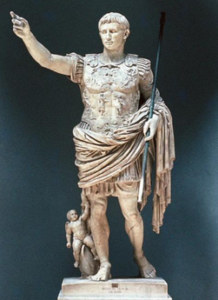 his armor. Although he was meant to be a fierce warrior his muscular build doesn’t stick out as unnatural rather a more relatable strength. A common representation of Roman art is Portraiture. It shows the fleshy naturalistic style the which was most common in their culture. They often used Portraiture for ancestry worship and had large funerary processions displaying ancestors.
his armor. Although he was meant to be a fierce warrior his muscular build doesn’t stick out as unnatural rather a more relatable strength. A common representation of Roman art is Portraiture. It shows the fleshy naturalistic style the which was most common in their culture. They often used Portraiture for ancestry worship and had large funerary processions displaying ancestors.
unit one summary
Well, to be honest, I’ve learned to look at art with a whole new perspective. Most of us just look at art and say wow what a splendid piece of work or etc. Due to learning about formal analysis, it actually helped me, well, give art a more thoughtful meaning for me. It inspires me to take more time to evaluate art in it’s meaning and why it was created. I was actually quite inspired with learning about formal analysis because it kinda gave special meaning rather than just calling it looking at a painting. I feel like the word “formal analysis” gives the definition more meaning and I guess it gives me inspiration to actually maybe do some formal analysis of my own when I go to a exhibit. I found learning this to be the most important in my opinion.
Formal Analysis
Formal analysis is basically looking towards a piece of art and trying to figure out the meaning, purpose and positions for why inspiration has taken place for these artworks. It’s the process of trying to skim the surface of what the artist is trying to express and display for the viewers. We look at the parts in which catches our eyes, parts in which expresses brighter colors than others. We look for the explanation in parts that we are able to question and observe and sympathize with the artist on their choices for each stroke. We could only infer what the artist could imply by their choices of scales in light or dark colors, or even warm or cold colors. Trying to see their composition and how we could read the story they’re trying to tell from their creation.
Unit 2 Summary
Art in the ancient world varied from nation to nation. The Mesopotamian’s had sculptures of people that would pose but lacked in depth features and characteristic’s. For example, Kouros from six hundred BC, depicts a person standing with their left foot out and their right foot back to keep some form of balance for the sculpture. This is also seen in the sculpture also named Kouros but was found in Anavysos and was made approximately 530 BCE. At first glance the two are almost copy’s of each other however have slight differences. Such as the toning and definition given to the second Kouros’s torso. The head isn’t elongated as the first sculpture and feels more expanded. The arms are larger as well as all other parts of the body in the second sculpture.
One thing that may stand out is how or why would different nations construct the same sculptures with only minor differences? In the Ancient Era when nations pillaged the other they would claim not only the city and population, but also absorb a piece of their culture and art pieces. If not by war were the sculptures plundered it was simply through cultural diffusion and trade of knowledge. Later on the ancient Greeks made their own version of Kouros; It is named Polykleitos, Doryphoros made around 450-440 BCE. In this version of the Kouros, the sculpture is more muscular and more defined than previous versions. It resembles a more realistic depiction of a Greek athlete male in his youth. The foot work is similar in that the right foot is forward but the left leg is back with a bend to give a sort of balance to the sculpture. The right arm is not put down and side to side but are active, which symbolizes he could be holding either a spear or flag further creating the assumption he is a solider of some kind.
Much after the Greeks had their rise to prominence, another nation rose from it’s luster. The Roman Republic which later became the Roman Empire adopted much of the culture form the Greeks, this includes a basic democratic system as well as sculpture and art. One Roman sculpture has similarities to the previously mentioned Polykleitos, Doryphoros, it is Augustus of Prima. The Roman Republic at the time turned into the Roman Empire due to its civil war between Augustus Caesar and Pompey. It concluded in Pompey’s defeat when he was found executed by the Alexandrian’s to present to Julius as a extension of faith. The resulting civil war caused the the public to be uncertain of what would come next. Augustus knew how important self image was, and that being the legitimate ruler of Rome was a important to not only show but enforce unto himself. To show the strength and the military ferocity of their new leader he erected many statues such as the Augustus of Prima. The statue is very much similar to the Polykleitos, Doryphoros; for example the footwork is the exact same style as the Greek version. As well as the left side of the body positioned to hold a spear. The notable differences is only the features on the head and hair which depict Augustus Caesar.



Unit 2 Summary
Both Greek and Roman art have similarities in the way that they both usually make art that represents their leaders such as sculptures. They both also have many different monuments that honor history that have been made after a significant event.
Something that differentiates Greek and Roman art a lot is that Roman artists did not strive to create perfect representations of human forms. They created sculptures of emperors exaggerating their art to show power of the emperors however something that Romans did was they put into consideration all of the flaws that the rulers had whether it had been saggy skin, skinny, or modest build. The Greeks also made their rulers look very powerful and made them look great however, they made the rulers look perfect like they gave them clear skin a good lean build made them tall and they were also symmetrical. I thought that this Separated them the most because it showed how the Greeks wanted people to look back on them like they were this great genetically perfect species that were powerful and perfect. The Romans wanted people to look back and see exactly what their rulers look like and they wanted people to remember more than anything. This is why roman art felt more genuine when looking at Greek art it makes you say yeah right and you doubt the authenticity of the people that are in the piece of art.
Something that they both have in common is that aesthetic aside they both want to make their rulers look powerful they like to make their rulers the center of attention. Something that looks as if similar is the material that was used to create these sculptures they both look as if they used limestone or marble in order to craft their monuments. Both of these places thrived around the same time period so a lot of their work looks similar and can be mistaken to be from either side.
Both of these look as if they take influence from each other after doing a bit of research Roman art was considered “copied” from the Greeks and that is why it is valued as less than the Greek pieces. I also discovered that both the Greeks and the Romans like to depict the gods although they go by different names in each culture such as Neptune and Poseidon.
Something that these culture have also shown is that they are both very fierce and they are not afraid to show violence in their works and depict how merciless they were in war and how they kill the prisoners in war. Both of these places loved to show how powerful they were and flaunted their power in their works of art they wanted to seem powerful so they would both dishonor the other works of art from other countries by defacing them and making their own pieces of art over them they might even change the face of the pieces of work into the faces of their emperors. Often they would make the most powerful people the biggest in works of art and they would emphasize this so that people can assume the most important people.






